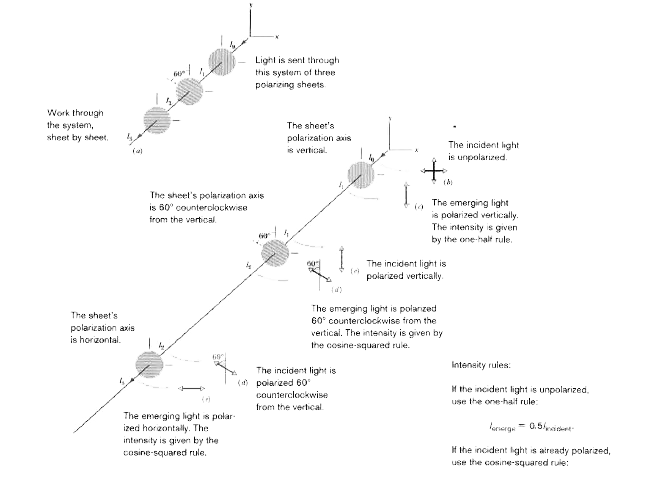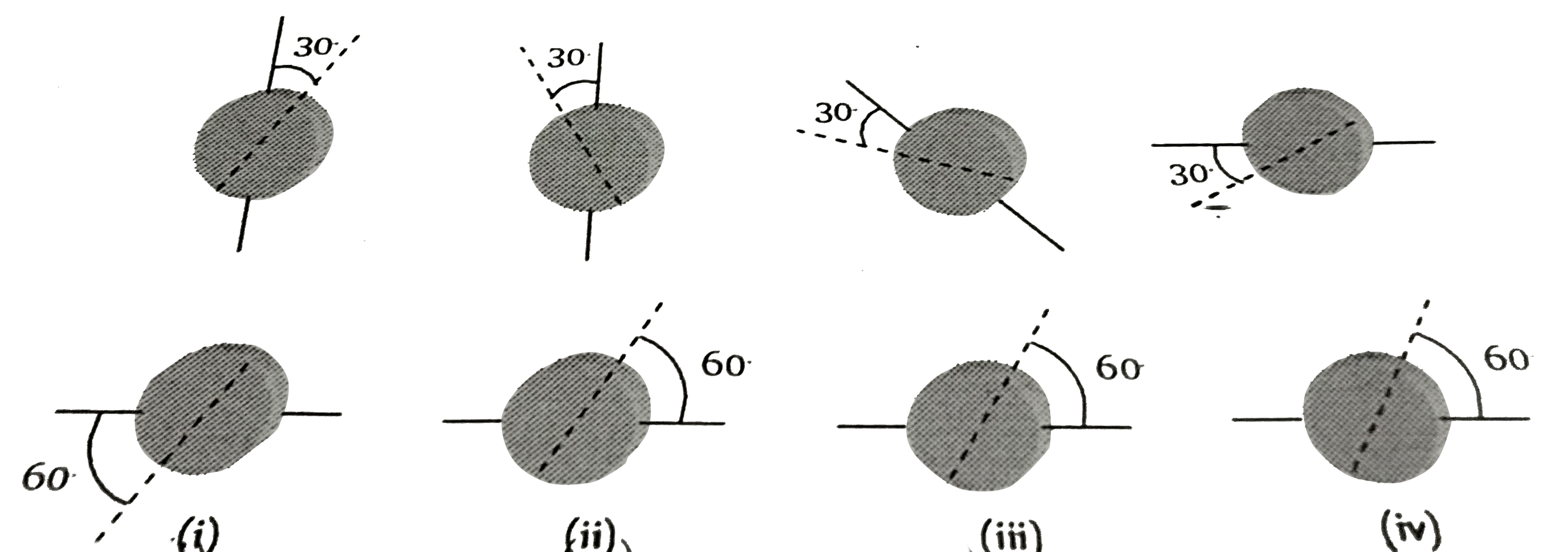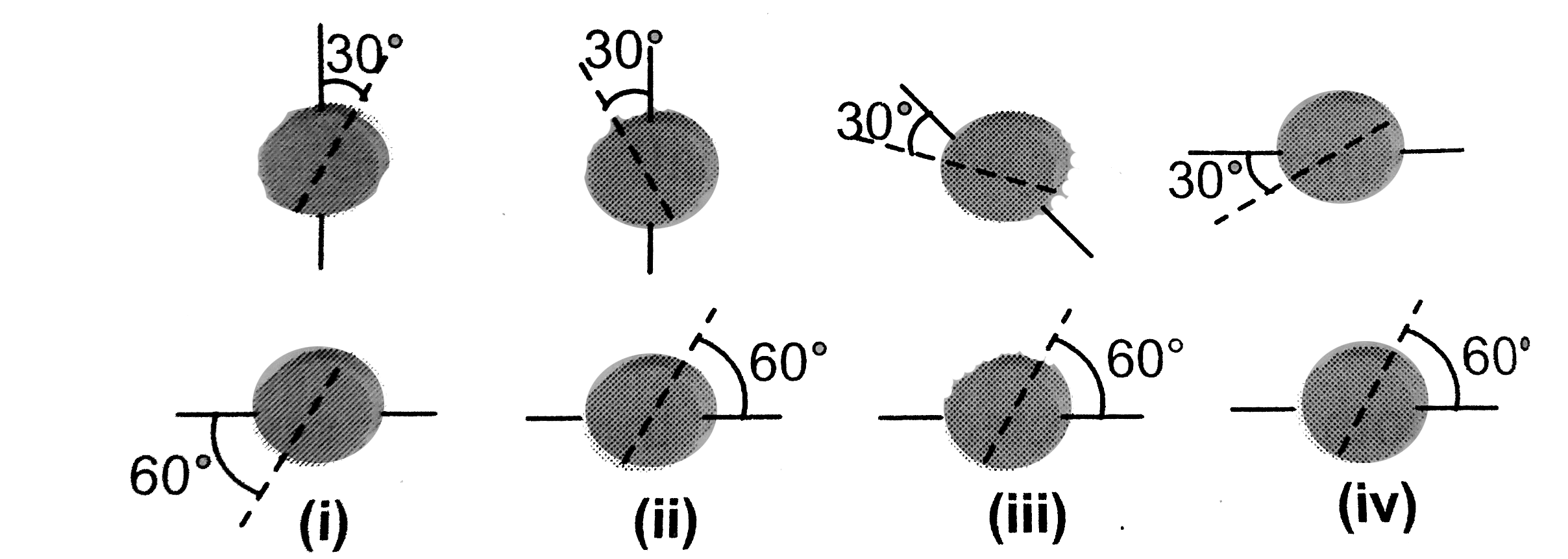Figure 32-15a, drawn in perspective, shows a system of three polarizing sheets in the palh of initially uL1polarized light. The polarizing direction of the first sheet is parallel to the y axis, that of the second sheet is al an angle of 60° counterclockwise from the y axis, and thaL of the third sheet is parallel to the x axis. What fraction of the initial intensity I0 of the light emerges from the three-sheet system. and in which direction is that emerging light polarized?
1. We work through the system sheet by sheet, Crom the first one encountered by the light to the last one.
2. .Tu find the intensity transmitted by any sheet, we apply either the one-half rule or the cosine-squared rule, depending, on whether the light reaching the sheet is unpolarized or already polarized.
3. The light thaL is tTansmitted by a polarizing sheet is always polarized parallel to the polariring direction of the sheet.
First sheet: The original light wave is represented in Fig. 32-lSb, using, the head-on,double-arrow representation of Fig. 32-10 b. Because the light is initially unpolarized, the intensity I1 of the light tnmsmitted by the first sheet is given by the one-half rule (Eq. 32-31):
I1=12I0
Because the polarizing direction of the first sheet is parallel to the y axis, the polarization of the light transmitted by it is also, as shown in the head-on view of Fig. 32-15c. Second sheet: Because the light r eaching the second sheet is polarized, the intensity I2 of the light transmitted by that sheet is given by the cosine-squared rule (Eq. 32-33). The angle θ in the rule is the angle between the polarization direction of the entering Light (parallel to the y axis) and the polarizing direction of the second sheet (60∘ counterclockwise Crom the y axis), and so θ is 60∘ . (The larger angle between the two dfrections, namely 120∘ , can also be used.) We have
I2=I1cos260∘ .
The polarization of this transmitted light is parallel to the polarizing di reclion of the sheet transmitting it-that is 60∘ counterclockwise from they axis, as shown in the head-on view of Fig. 32-15 d.

Figure (a) Initially unpolarized light or intensity I0 is sent into a system of three polarizing sheets. The intensities I1,I2and I3 of the light transmitted by tbe sheets are labeled. Shown also are the polarizations, from bead-on views, of (b) the initial light and the light lransmicted by (c) the first sheet, (d) the second sheet, and (e) the third sheet.
Third sheet: Because the Hght reaching the third sheet is polarized, the intensity I3 of the light transmitted by that sheet is given by the cosine-squared rule. The angle θ is now the angle between the polarization direction of the entering light (Fig. 32-15 d) and the polarizing direction of the third sheet (parallel to the x axis), and so θ=30° . Thus
I3=I2cos230∘ .
This final transmitted light is polarized parallel to the x axis (Fig. 32-15e). We find its intensity by substituting first for I2 and then for I1 in the equation above:
I3=I2cos230∘=(I1cos260∘)cos230∘
=(12I0)cos260∘30∘=0.094I0 .
Thus I3I0=0.094 . ( Answer )
That is to say, 9.4% of the initial intensity emerges from the three-sheet system. (If we now remove the second sheet, what fraction of the initial intensity emerges from the system?)
Topper's Solved these Questions
- ELECTROMAGNETIC WAVES BOOK - RESNICK AND HALLIDAYCHAPTER - ELECTROMAGNETIC WAVES EXERCISE - CHECKPOINT
3 Videos
- ELECTROMAGNETIC WAVES BOOK - RESNICK AND HALLIDAYCHAPTER - ELECTROMAGNETIC WAVES EXERCISE - PROBLEMS
29 Videos
- ELECTROMAGNETIC OSCILLATIONS AND ALTERNATING CURRENT BOOK - RESNICK AND HALLIDAYCHAPTER - ELECTROMAGNETIC OSCILLATIONS AND ALTERNATING CURRENT EXERCISE - Practice Questions (Integer)
7 Videos
- FLUIDSBOOK - RESNICK AND HALLIDAYCHAPTER - FLUIDSEXERCISE - PRACTICE QUESTIONS (Integer Type )
5 Videos
Similar Questions
An unpolarized light is travelling along Z axis through three polarizing sheets. The polarzing direction of the first and third sheet are respectively parallel to X axis and Y axis whereas that of the second one is at 60∘ to the Y axis. Then, the fraction of the initial light intensity that emerges from the system in about,
View SolutionA beam of polarized light is sent into a system of two polarizing sheets . Relative to the polarization diretion of that incident light the polarizing direction of the sheets are at angles θ for the first sheet and 90∘ for the second sheet . (a ) If 0.20 of the incident intensity is transmitted by the two sheets what is θ (b ) What percentage of the incident intensity is transmitted if the first sheet angle is reduced to 0∘ ?
View Solution
Knowledge Check
An unpolarized light is travelling along Z axis through three polarizing sheets. The polarzing direction of the first and third sheet are respectively parallel to X axis and Y axis whereas that of the second one is at 60∘ to the Y axis. Then, the fraction of the initial light intensity that emerges from the system in about,
AzeroB3I032CI032D9I032The figure shows four pairs of polarizing sheets, seen face-on. Each pair is mounted in the path of initially unpolarized light. The polarizing direction of each sheet (indicated by the dashed line) is referenced to either a horizontal x -axis or a vertical y axis. Rank the pair according to the fraction of the initial intensity that they pass, greatest first
 A(i)>(ii)>(iii)>(iv)B(i)>(iv)>(ii)>(iii)C(i)>(iii)>(ii)>(iv)D(iv)>(iii)>(ii)>(i)
A(i)>(ii)>(iii)>(iv)B(i)>(iv)>(ii)>(iii)C(i)>(iii)>(ii)>(iv)D(iv)>(iii)>(ii)>(i)The figure shows four pairs of polarizing sheets, seen face-on. Each pair is mounted in the path of initially unpolarised light. The polarizing direction of each sheet (indicated by the dashed line) is referenced to either a horizontal x-axis or a vertical y axis. Rank the pair according to the fraction of the initial intensity that they pass, greatest first
 A(a) (i)gt(ii)gt(iii)gt(iv)B(b) (i)gt(iv)gt(ii)gt(iii)C(c) (i)gt(iii)gt(ii)gt(iv)D(d) (iv)gt(iii)gt(ii)gt(i)
A(a) (i)gt(ii)gt(iii)gt(iv)B(b) (i)gt(iv)gt(ii)gt(iii)C(c) (i)gt(iii)gt(ii)gt(iv)D(d) (iv)gt(iii)gt(ii)gt(i)
In Fig 32-25 unpolarized light is sent into a system of three polarizing sheets. Which transmits 0.0500 of the initial light intensity . The polarizing directions of the first and third sheets are at angles θ1=0∘ and θ3=90∘ . What are the (a) smaller and (b ) larger possible values of angle θ2(<90∘) for the polaring direction of sheets 2?
View SolutionTwo polarising plates have polarising directions parallel score to trasmit maxmum intensity of light through what angle most either plate be turned in the intensites of the transmitted beam is to drop by half?
View SolutionA horizontal beam of vertically polarized light of intensity 43W/m2 is sent through two polarizing sheets. The polarizing direaction of the first is 60∘ to the vertical, and that of the second is horizontal. The intensity of the light transmitted b y the pair of sheets is (nearly)
View SolutionThree polarizing sheets are placed in a stack with the polarizing directions of the first and third perpendicular to each other. What angle should the polarizing direction of the middle sheet make with the polarizing direction of the first sheet to obtain maximum transmitted intensity when unpolarized light is incident on the stack ?
View SolutionUnpolarising light on two polarizing sheets so oriented that is transmitted. If a third polarizing sheet is placed between them, not parallel to either of the above two sheets in question
View Solution
